|
|
 |
Many decades ago, a famous racer and tuner named Wal Phillips invented and marketed a fuel injection system for motorcycle and small automobile engines. The system was intended as a high performance replacement for the Amal carburetors commonly used in such applications. The original literature (see below for samples) indicate that the Monobloc flange (2-bolt pattern on 2.0 or approximately 50.8mm horizontal bolt centers, using 5/16 bolts or studs) was used on all models. However, the largest injector sizes may have used the larger 65mm (2.559”) Amal 2-bolt pattern as found on the largest (1-3/8,1-1/2”, &c.) 3 GP and 5 GP carburetors.
Here are the eight original models in fractional and decimal throat sizes, with metric equivalents. |
WP Size |
1” | 1-1/16” | 1-1/8” | 1-3/16” | 1-1/4” | 1-3/8” | 1-1/2”1-5/8” | |
Decimal Size | 1.000” | 1.0625” | 1.125” | 1.1875” | 1.250” | 1.375” | 1.500”1.625” | |
Metric Size | 25.4mm | 27.0mm | 28.6mm | 30.2mm | 31.8mm | 34.9mm | 38.1mm | 41.3mm |
The selection of size should begin with the throat size or slightly larger of the original Amal carburetor used on the “sports” model of your engine, but not more than roughly 4mm above the intake port size.
Even though the system is entirely self-contained and has no fuel pump, it is still a true injector since fuel flow is delivered by low pressure (gravity) rather than engine demand (vacuum); there is no venturi. Metering is based on throttle position and injector adjustments rather than changes in air-flow indirectly caused by throttle position.
The fuel pressure will vary depending on the height of the tank above the injector, the level of gas in the tank, etc. (pressure ~ gravity × height difference × weight of fuel in tank). Fuel pressure can be stabilized and made “normal” by using a float bowl, so that the height and weight are constant and won’t vary with amount of fuel in the tank (at least, until it’s almost empty). Obviously, the bowl’s fuel level must be above the injector inlet, and this height differential will affect the mixture. The pressure will be less, since the bowl is lower than the fuel in the tank. The bowl(s) should be as high as possible so that the pressure differential between the fuel in the tank and in the bowl is reduced; otherwise this will make all injector settings too lean and interfere with tuning.
My choice is a remote bowl (or two) from an SU. You might be able to get by with a single bowl and split the line for dual injectors, but the needle & seat aren’t large enough to feed both injectors under gravity only and should be replaced with an aftermarket bowl cover (Rivera Engineering makes one for the SU but I don’t know which models it fits), a bit of shade tree engineering to cobble a larger needle & seat assembly into the existing cover, or use two bowls to insure adequate fuel supply. Other alternate bowls: Dell’Orto SS, Amal GP, TT, 289 etc.
No carburetor or injector completely atomizes the mixture, nor is this desirable. Larger fuel droplets require higher charge velocity to remain suspended in the airstream and successful carriage into the chamber. However, there is a maximum droplet size beyond which mixture quality in the combustion chamber will not be homogeneous, with lean and rich areas yielding incomplete combustion and poor mileage. The volume of fuel discharged into the airstream in the injector is a function of pressure and aperture size; lower pressure will always require a larger orifice to give the same mixture balance.
However, even though the same total proportion of air & gas may result from different combinations of pressure and orifice size, the combination of low pressure and large orifice will produce larger droplet size for the same volume than the reverse: higher pressure and smaller orifice size.
If circumstances permit, in my opinion a small low pressure solid-state electric pump such as the Fawcett, or a crank-case pressure operated diaphragm pump such as the Mikuni will provide greater performance. Even though the larger orifice size needed for proper mixture may prove to be within the ajustment range of the injector, the low pressure will result in a larger droplet size entering the intake port. A pump with an adjustable pressure regulator allows some range of adjustment without touching the injector itself, and provides a useful tuning aid.
Petcock: use an engine-vacuum operated type, as used on late Harley or older Kawasaki (My 1972 H2 had one), so you don’t have to turn it off.
To improve idle quality, tap into the intake manifold right after the injector body (so as not to modify the WP itself) and install a small fitting with a needle valve and a hose going to the air cleaner backing plate. This permits metering air into the motor directly (similar to an IAS on EFI), and it gets air from a filtered source.
Another much larger fitting can admit metered air (fitted with big jet?) to tune mid-range constant throttle for best engine temp and mileage without affecting the full-throttle curve (as WP specified). |
From the original instructions:
“Fitting & Tuning instructions for the Wal Phillips fuel injector
Fitting notes: To allow clearance for JET LEVER it is sometimes necessary to file the RIGHT HAND (offside) nut, also with some machines the stud may have to be shortened. To avoid distortion of the flange ensure that both nuts are tightened equally. Couple up the original throttle cable, not forgetting to place the spring between the cable stop and lever, and then connect plastic petrol feed pipe. The injector is now ready for test.
Starting the machine:
1. Open petrol tap.
2. Kick over the engine as normal.
3. Should the engine flood, switch off petrol, open the throttle wide and kick over the engine a few times.
4. Always stop the engine by turning off the petrol, leaving the injector dry for instant starting.
The Phillips Fuel Injector is a very simple design. The jet assembly is in effect a petrol tap. The butterfly is in effect an air tap. The levers are arranged so that the tuning of the first half of the throttle - taking the link down the long threaded lever for richer, or up for weaker - does not upset the basic full open setting. The second half of the throttle travel-top end-tuning is controlled by the throttle stop - say by one turn - and then lengthening the connecting link to bring the butterfly back again to the fully open position. This will weaken the mixture right down through the range, and call for a richening of the first half of throttle travel (bottom end). Tune the bottom end with the engine running, and when a clean pickup is obtained (lagging response and spitting back means too weak. Eight stroking and black smoke means too rich) open the throttle fully very quickly and watch the exhaust. Should black smoke appear as the revs mount well up the range the top end is too rich. Adjust weaker as described (not forgetting to reset bottom end) until black smoke has cleared. Then road test and finally tune top end to plug reading.
The idling stop should be set and at the same time the throttle cable must be adjusted precisely without slack, otherwise the throttle return spring will overcome the spring in the link thimble, and allow the jet to shut right off, so stalling the engine.
Bias on the side of vertical turns (on one unit) may be located by slackering off one side flange nut - with the other side not fully tight, and puching the unit over to make an air leak. If this is done with the engine running at near idle and the bad cylinder begins to fire this is the rich side. Now remove unit and make a small air leak that side, by cutting a little groove in a fibre manifold gasket (which may be fitted if one is not already there). All this is well worthwhile to get the superb instant response, and clear cut power gain that the injector will give.
Twin injectors:
Fit separate pipe and tap to each unit so that after starting up, one side may be switched off whilst the other is tuned to run clear, right up the range. Then switch over to the first side and tune it likewhise. Level butterflies with cable and adjusters. Tune top-end to plug readings.
Basic setting: Your injector is adjusted to a basic setting and the clamps should not be disturbed. If, however, by accident the clamps are moved use the following procedure:
1. Insert a (proper size) drill shank through the fuel feed hole, so that it is visible in the injector bore. This lines up jet in open position.
2. The left hand clamped lever must be hard against the throttle stop screw and the jet block.
3. The butterfly must be in the horizontal fully open position. Adjustment is carried out by altering the length of the connecting link
4. Arrange that connecting link is at approximately right angle to threaded lever when is fully open position. NO END FLOAT at jet spindle.” |
From Wal Phillips: |
“Having fitted a fuel injector you must remember that it involves different handling of the machine. This is not difficult, but it is essential to follow the instructions to get best results.
Starting the scooter:
Turn the fuel on at the last possible moment, and kick over as normal. Hold the throttle steaily, just a little open and blip the throttle on | |
|
and off as soon as the engine gets running. To stop the engine, turn fuel tap off. Should the engine not fire right away it may flood up with fuel, so turn the fuel tap off and kick the engine over with the throttle wide open to clear it.
Should the engine burst into life now, quickly turn on the fuel and try to keep it running by blipping the throttle on and off while the bottom end (or first half) of the throttle range is adjusted. Always adjust the bottom end settinf with the engine running.
Flat spot:
Delayed response to the throttle movemement or a flat spot signifies a weak mixture. This may be rectified by taking the connecting link down the threaded jet lever, having the lock nuts already finger tight only so that the adjustment may be made with the engine running.
Heavy smoke: uneven running (eight-stroking) plus black or heavy blue smoke form the exhaust signifies an over rich mixture. This may be corrected by adjustment up the threaded lever. This allows the jet, which is in effect a jet-sized petrol tap, to shut off a little in relation to the butterfly, thus weakening the mixture.
Tuning the top half:
The above adjustments will have been made with the throttle not more than half open, so you have tuned the bottom half. Having got the bottom end reasonably clean, thighten the lock nut - always the same one - and start on the upper half.
With the engine in neutral quickly open the throttle at last as the engine will take it and listen as the revs mount right through the range. At full revs in neutral gear the exhaust note wants to change from clean two-stroking to a slightly uneven rich sound.
Should this note come in earlier up the range and be accompanied by excessive blue smoke, the top end is too rich.
Adjust the top end weaker by screwing down the throttle stop screw one turn and lengthening the link until the butterfly is restored to its fully-open position. This will weaken the mixture right through the range, and two or three turns down the threaded lever will be needed right away to correct the bottom end weakness.
Restart, re-tune the bottom end and check the full throttle sound again. When the required result has been obtained - that little uneven or blabbing palse of uneven at full revs - it is in order to go out on the road and in due course carry out the final top and tuning adjustment to the point of a plug check.
Have a short burst of full throttle in third or top gear. Switch off the fuel and coast to a standstill. Examine the plug points. White, dry plug condition means weak mixture and a risk of engine seizure. Light or full brown colour is fine. Black means too rich.” |
Here are some illustrations and diagrams; click any to see a larger view on a separate page |
See these other Victory Library booklets |
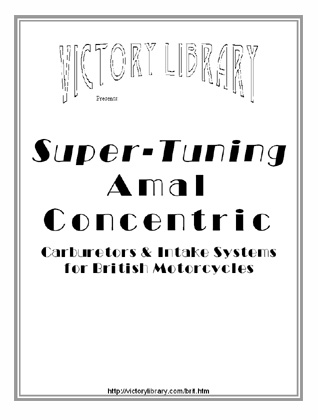
| 
| 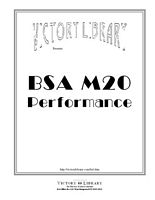
| 
| 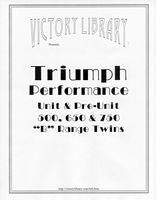
| 
| 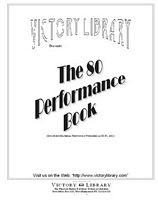
| 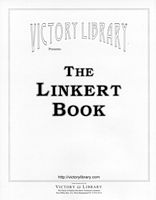
| 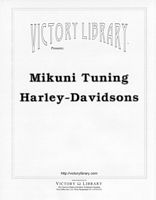
|
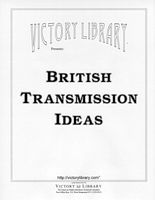
| 
|
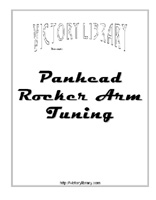
|
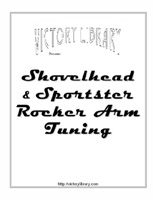
|
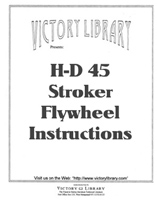
|
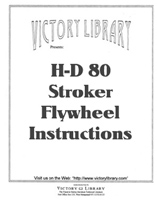
|

|
|